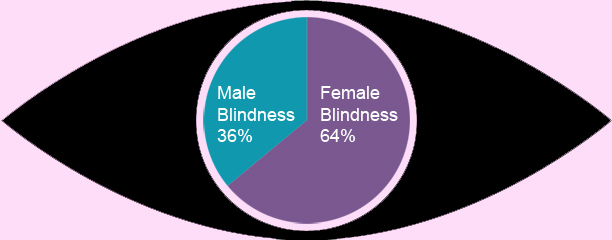Did you know that two-thirds of the world’s blind are women?
For International Women’s Day, RIIO is focusing on gender and eye health.
What do we know?
Globally, women bear a greater burden of blindness than men.
- A meta-analysis of population based surveys on blindness prevalence in Asia, Africa and industrialized countries indicates that women bear approximately two-thirds of the burden of blindness in the world.
Biology and gender inequalities combine to create these gendered health outcomes
- The larger number of elderly females may contribute substantially to the excess female blindness in countries where women tend to outlive men. For example, age related macular degeneration, a disease with no effective treatment and the most common cause of blindness in developed countries, affects mostly those over 70 years.
- In Asia and Africa, the major cause of blindness in cataract, which can be cured by simple surgery. Population-based surveys from five countries in Asia and Africa show that women account for between 53% and 72% of all people living with cataract. Further, women do not receive surgery at the same rate as men. Barriers that prevent both men and women from receiving surgery are often more problematic for women. They include:
- Cost of surgery: Women often have less access to family financial resources to pay for eye care or transportation to reach services.
- Inability to travel to a surgical facility: Women often have fewer options for travel than men. Older men may require assistance, which poorer families may not be able to provide.
- Differences in the perceived value of surgery: Cataract is often viewed as an inevitable consequence of ageing and women are less likely to have social support in a family to seek care.
- Lack of access to information and resources: Female literacy is often lower than male literacy, especially among the elderly. Thus, women are less likely to know about the possibility of treatment for eye disease or where to go to receive it.
- Fear of a poor outcome: To this day, women are discouraged from wearing glasses in many societies. If cataract surgery does not have a good refractive outcome, women are more likely to be functionally blind than men after surgery.
- Trachoma, another prominent cause of blindness in developing countries (though, fortunately not in Rwanda), is also more common in women than men. Since women and older girls are the primary childcare providers, they acquire active trachoma from young children.
What research is needed?
- More population-based data from Latin America, South America and the former Soviet Union to evaluate the issue of gender and blindness.
- Further research on how gender inequality influences blindness rates and access to care, all over the world.
- Where the use of services is unequal, we need to test methods to rectify the imbalance.
What are the implications for policies and programs?
- Awareness of the problem is needed to generate political will to address sex differentials and gender inequities in use of eye care services.
- At the local level it is important to identify the barriers that prevent women from receiving eye care services and to design gender-sensitive programmes to reduce these. Peer motivators (for example, women talking to other women) are likely to be more effective than health workers in promoting the use of eye care services.
- National and local prevention of blindness programmes should monitor cataract surgical coverage and trichiasis surgical coverage rates by sex as well as monitor surgical outcome of surgery by sex. Discrepancies discovered should be investigated.
- Global awareness of, and local approaches to, improving gender equity in eye care services use will be critical steps in achieving the goals of VISION 2020.
Unless we make special efforts to ensure eye services for women the correctable disparities in blindness prevalence between men and women will continue.

 My name is Dr. Norbert Uzabumwana, I am a first year resident at RIIO. I am Rwandan and I have been working as General practitioner working for the public hospital for 5 years before joining the residency. Some years back, my grandfather had an eye condition that ended up blinding him. Since that time his life changed forever. As I grew up looking for my future career I realized that there is nothing great compared to restoring the sight for people. Even though there is shortage of doctors in the whole country, but the field of eye health is among the most affected. The path to choosing my medical career brought me to ophthalmology.
My name is Dr. Norbert Uzabumwana, I am a first year resident at RIIO. I am Rwandan and I have been working as General practitioner working for the public hospital for 5 years before joining the residency. Some years back, my grandfather had an eye condition that ended up blinding him. Since that time his life changed forever. As I grew up looking for my future career I realized that there is nothing great compared to restoring the sight for people. Even though there is shortage of doctors in the whole country, but the field of eye health is among the most affected. The path to choosing my medical career brought me to ophthalmology. Dr. KWIZERA Jean Rene is currently a resident in the Department of Ophthalmology at RIIO-COESCA With a passion for vision health and patient care; He is dedicated to making a meaningful impact in the lives of patients through both medical and surgical interventions.
Dr. KWIZERA Jean Rene is currently a resident in the Department of Ophthalmology at RIIO-COESCA With a passion for vision health and patient care; He is dedicated to making a meaningful impact in the lives of patients through both medical and surgical interventions. My name is Gad DUSENGIMANA, and I am a medical doctor. Growing up in Rwanda, when I was a child, I witnessed many people suffering from blindness especially in rural area, they were walking through life without the care they needed. This struggle became personal when my grandfather lost his sight in both eyes. I vividly remember walking with him, holding a stick to guide him as he followed behind me. We lost hope for his vision due to the lack of access to healthcare, and it was during these moments that I realized the severe shortage of ophthalmologists in our country, where even preventable blindness was often left untreated.
My name is Gad DUSENGIMANA, and I am a medical doctor. Growing up in Rwanda, when I was a child, I witnessed many people suffering from blindness especially in rural area, they were walking through life without the care they needed. This struggle became personal when my grandfather lost his sight in both eyes. I vividly remember walking with him, holding a stick to guide him as he followed behind me. We lost hope for his vision due to the lack of access to healthcare, and it was during these moments that I realized the severe shortage of ophthalmologists in our country, where even preventable blindness was often left untreated. I am Dr. Moise ISHIMWE SEBIKARI, PGY 1 Resident at Rwanda International Institute of Ophthalmology RIIO. I chose to join ophthalmology because I found scarcity of ophthalmology in developing countries, especially here I Rwanda, yet a huge number of people with eye diseases, some of them which are totally avoidable and treatable, and I found in myself one of the answer.Since then I looked for the opportunity to help me to achieve my dreams that is when I knew RIIO, and applied for Resident in ophthalmology. Unfortunately for the first time in 2021, I did not pass well but also I had kept trying to do application because of the way I really liked ophthalmology. Later one I Applied again in 2022, I did exams and a got admission in 2023.
I am Dr. Moise ISHIMWE SEBIKARI, PGY 1 Resident at Rwanda International Institute of Ophthalmology RIIO. I chose to join ophthalmology because I found scarcity of ophthalmology in developing countries, especially here I Rwanda, yet a huge number of people with eye diseases, some of them which are totally avoidable and treatable, and I found in myself one of the answer.Since then I looked for the opportunity to help me to achieve my dreams that is when I knew RIIO, and applied for Resident in ophthalmology. Unfortunately for the first time in 2021, I did not pass well but also I had kept trying to do application because of the way I really liked ophthalmology. Later one I Applied again in 2022, I did exams and a got admission in 2023. Dr Jean de Dieu Ntivuguruzwa,In 2019, he was deployed at Butaro Hospital as an intern Medical Doctor for a period of 12 months, from where after he was deployed at Byumba Distric Hospital by Rwanda MOH as a General Practitioner (02/08/2021). Since then he started searching information on how he can find a school of Ophthalmology, after finding that there is a large gap of ophthalmologists in different hospitals (including where I was practicing).
Dr Jean de Dieu Ntivuguruzwa,In 2019, he was deployed at Butaro Hospital as an intern Medical Doctor for a period of 12 months, from where after he was deployed at Byumba Distric Hospital by Rwanda MOH as a General Practitioner (02/08/2021). Since then he started searching information on how he can find a school of Ophthalmology, after finding that there is a large gap of ophthalmologists in different hospitals (including where I was practicing). Dr ANNA Major, Emerging from the serene Caribbean Island of The Bahamas, Anna Major stands as a first-year post-graduate resident at the Rwanda International Institute of Ophthalmology (RIIO). Her fervor for ophthalmology took root during her medical school days that was sparked by a poignant encounter with a young mother grappling with the harsh reality of irreversible vision loss due to uncontrolled diabetes. As Anna embarked on her chosen career trajectory, she actively engaged in numerous ophthalmic research projects and altruistic endeavors, both as a medical student and as a practicing physician.
Dr ANNA Major, Emerging from the serene Caribbean Island of The Bahamas, Anna Major stands as a first-year post-graduate resident at the Rwanda International Institute of Ophthalmology (RIIO). Her fervor for ophthalmology took root during her medical school days that was sparked by a poignant encounter with a young mother grappling with the harsh reality of irreversible vision loss due to uncontrolled diabetes. As Anna embarked on her chosen career trajectory, she actively engaged in numerous ophthalmic research projects and altruistic endeavors, both as a medical student and as a practicing physician. In Rwanda, eye conditions are still a burden of our society. There is a gap of Ophthalmologists countrywide, existing specialists are only based in the Referral Hospitals and some private clinics. From a five year experience I had as General Practitioner in different District Hospitals of Rwanda, I realized that my undergraduate background in Ophthalmology is not sufficient to serve patients with eye problems, and for this reason, I have joined Ophthalmology residency at RIIO school of Ophthalmology where I am now gaining more experiences from different experts all over the World, clinical skills that are parallel to the surgical skills through wet labs where special instruments are used enhance our learning quality.
In Rwanda, eye conditions are still a burden of our society. There is a gap of Ophthalmologists countrywide, existing specialists are only based in the Referral Hospitals and some private clinics. From a five year experience I had as General Practitioner in different District Hospitals of Rwanda, I realized that my undergraduate background in Ophthalmology is not sufficient to serve patients with eye problems, and for this reason, I have joined Ophthalmology residency at RIIO school of Ophthalmology where I am now gaining more experiences from different experts all over the World, clinical skills that are parallel to the surgical skills through wet labs where special instruments are used enhance our learning quality. My first 30 days at Rwanda International Institute of Ophthalmology were full of new experiences of learning. Before joining RIIO, I spent more than 18 years in school, from nursery, primary, high school as well as undergraduate medical school, all of which were almost similar in learning and teaching methods. After medical school, I realized I had some deficiency in ophthalmology knowledge, and I embarked on the way of learning some principles in that strange field, which landed me in RIIO as a resident.
My first 30 days at Rwanda International Institute of Ophthalmology were full of new experiences of learning. Before joining RIIO, I spent more than 18 years in school, from nursery, primary, high school as well as undergraduate medical school, all of which were almost similar in learning and teaching methods. After medical school, I realized I had some deficiency in ophthalmology knowledge, and I embarked on the way of learning some principles in that strange field, which landed me in RIIO as a resident. In pursuit of purpose, I ended up in the Rwanda International Institute of Ophthalmology to begin my dream career. This was the first time I was leaving my country for a foreign land. Like Abraham of old, it felt like leaving the known for the unknown & uncertain. Nevertheless, I didn’t hesitate to heed the call. This past (almost) two months have been wonderful. I especially like the learning style, the paperless approach to doing most things & the friendly staff that make my time here all the more bearable & worthwhile. I have definitely grown and look forward to more exciting times of learning & GROWTH.
In pursuit of purpose, I ended up in the Rwanda International Institute of Ophthalmology to begin my dream career. This was the first time I was leaving my country for a foreign land. Like Abraham of old, it felt like leaving the known for the unknown & uncertain. Nevertheless, I didn’t hesitate to heed the call. This past (almost) two months have been wonderful. I especially like the learning style, the paperless approach to doing most things & the friendly staff that make my time here all the more bearable & worthwhile. I have definitely grown and look forward to more exciting times of learning & GROWTH. As a young man growing up in the village, I watched my grandmother grow progressively blind from what I later came to learn was cataracts. She became suicidal and her life came to a halt. For those who grow up in the village you know the role of a grandmother to the community, she was the one left to care for the domestic animals, raise all the kids while everyone went out to work, made sure we the kids were fed and cared for amongst many other roles within the homestead. So with her blindness, her roles stopped and the family was slowly disintegrating.
As a young man growing up in the village, I watched my grandmother grow progressively blind from what I later came to learn was cataracts. She became suicidal and her life came to a halt. For those who grow up in the village you know the role of a grandmother to the community, she was the one left to care for the domestic animals, raise all the kids while everyone went out to work, made sure we the kids were fed and cared for amongst many other roles within the homestead. So with her blindness, her roles stopped and the family was slowly disintegrating. I am Dr. IMANIRIHO Jean Damascene, an RIIO resident working to become an ophthalmologist. I have been working as a general practitioner in Rwandan public and private hospitals, located in rural and urban regions, for four years before joining RIIO. I am driven by helping people in need. After being treated for an ocular condition while doing my first year of medical school, I remarked how vision impacts people’s lives and decided to become an ophthalmologist. For me, vision is equivalent to live.
I am Dr. IMANIRIHO Jean Damascene, an RIIO resident working to become an ophthalmologist. I have been working as a general practitioner in Rwandan public and private hospitals, located in rural and urban regions, for four years before joining RIIO. I am driven by helping people in need. After being treated for an ocular condition while doing my first year of medical school, I remarked how vision impacts people’s lives and decided to become an ophthalmologist. For me, vision is equivalent to live. I am Elie, a Rwandan medical doctor. I have been observing the burden of blindness specifically avoidable blindness across the world but mostly in the developing world and found that blindness and eye care, in general, are still marginalized hence they are among the most devastating conditions for health. So, I thought about bringing my contribution to this noble cause. As Mandela said, “education is the only weapon we can use to change the world” for me too, ophthalmology education was the only weapon I could use to beat blindness as well as take eye care to the next level; so I joined RIIO to fully prepare myself to this; RIIO is not only the home institution but also I consider their expertise in the field of ophthalmology as an added value to fulfilling my objectives.
I am Elie, a Rwandan medical doctor. I have been observing the burden of blindness specifically avoidable blindness across the world but mostly in the developing world and found that blindness and eye care, in general, are still marginalized hence they are among the most devastating conditions for health. So, I thought about bringing my contribution to this noble cause. As Mandela said, “education is the only weapon we can use to change the world” for me too, ophthalmology education was the only weapon I could use to beat blindness as well as take eye care to the next level; so I joined RIIO to fully prepare myself to this; RIIO is not only the home institution but also I consider their expertise in the field of ophthalmology as an added value to fulfilling my objectives. I am Dr. Gilbert NSHIMIYIMANA.I am one of those who think that one of the greatest gifts that God gave man is “SIGHT”.I strive to provide and maintain quality eye care services and that has always been my dream. Rwanda is one of the developing countries suffering from blindness specifically avoidable blindness due to many factors, one of them being few trained eye care specialists (ophthalmologists). By Joining RIIO, my dream did not only come true but also I strongly believe it will enable us to take quality eye health solutions to the next better level.
I am Dr. Gilbert NSHIMIYIMANA.I am one of those who think that one of the greatest gifts that God gave man is “SIGHT”.I strive to provide and maintain quality eye care services and that has always been my dream. Rwanda is one of the developing countries suffering from blindness specifically avoidable blindness due to many factors, one of them being few trained eye care specialists (ophthalmologists). By Joining RIIO, my dream did not only come true but also I strongly believe it will enable us to take quality eye health solutions to the next better level. My name is David NGABO, Medical doctor, First Year Ophthalmology resident at RIIO. It has always been a dream of mine to be a solution orientated person, through that I always think about how I can contribute to the community. Finally, I realized that my passion is to help improve health by helping people with disabilities especially blindness to improve their quality of life. Joining the ophthalmology residency program at Rwanda International Institute of Ophthalmology(RIIO) is an opportunity for me due to the fact that RIIO has a dedicated team with different expertise and is ready to train young professionals. I believe that through this perspective, I will become a promising ophthalmologist, ready to provide a tremendous contribution to my country and in the region, especially in strengthening eye health care, education, and Research.
My name is David NGABO, Medical doctor, First Year Ophthalmology resident at RIIO. It has always been a dream of mine to be a solution orientated person, through that I always think about how I can contribute to the community. Finally, I realized that my passion is to help improve health by helping people with disabilities especially blindness to improve their quality of life. Joining the ophthalmology residency program at Rwanda International Institute of Ophthalmology(RIIO) is an opportunity for me due to the fact that RIIO has a dedicated team with different expertise and is ready to train young professionals. I believe that through this perspective, I will become a promising ophthalmologist, ready to provide a tremendous contribution to my country and in the region, especially in strengthening eye health care, education, and Research. My name is Eric MANIRAKIZA. I’m a Burundian Medical doctor and First-Year Ophthalmology resident at RIIO. After completing my studies at Hope Africa University in Burundi, I got a chance to work at VAN NORMAN clinic, which is the Clinic run by the same University where I got the opportunity to practice my medical career. After 3 years of practice, I got a great opportunity to be admitted to the Ophthalmology Residency Program at Rwanda International Institute of Ophthalmology (RIIO) which is the most accurate Institution in the region concerning its good purpose and values. I believe that through the education and training provided by RIIO, I will be among the future successful generation of ophthalmologists produced by RIIO, who are ready to give their contribution to their different countries and the region in general, especially in preventing avoidable blindness in the population of Africa.
My name is Eric MANIRAKIZA. I’m a Burundian Medical doctor and First-Year Ophthalmology resident at RIIO. After completing my studies at Hope Africa University in Burundi, I got a chance to work at VAN NORMAN clinic, which is the Clinic run by the same University where I got the opportunity to practice my medical career. After 3 years of practice, I got a great opportunity to be admitted to the Ophthalmology Residency Program at Rwanda International Institute of Ophthalmology (RIIO) which is the most accurate Institution in the region concerning its good purpose and values. I believe that through the education and training provided by RIIO, I will be among the future successful generation of ophthalmologists produced by RIIO, who are ready to give their contribution to their different countries and the region in general, especially in preventing avoidable blindness in the population of Africa. Je suis Dr KAVIRA MALIRO Valence, de nationalité Congolaise. Je suis née à Goma ou j’ai grandi, puis fait mes études en Médecine à l’université catholique de Bukavu(UCB). J’ai ensuite travaillé dans un projet belgo congolais dénomméAFIA SHULENI, ayant pour objectif d’améliorer les résultats scolairesdes enfants en leur assurant une bonne santé.Pendant ce temps, nous avons constaté que bon nombre d’enfants ne bénéficient pas de la consultation pré- scolaire avant de commencer l’école maternelle voir même primaire. J’ai fait partie de l’équipe chargée d’examinerdes enfants dans différentes écoles pour détecter des pathologies inconnues ou ignorées par les parents. Nous avons rencontré plusieurs problèmes.
Je suis Dr KAVIRA MALIRO Valence, de nationalité Congolaise. Je suis née à Goma ou j’ai grandi, puis fait mes études en Médecine à l’université catholique de Bukavu(UCB). J’ai ensuite travaillé dans un projet belgo congolais dénomméAFIA SHULENI, ayant pour objectif d’améliorer les résultats scolairesdes enfants en leur assurant une bonne santé.Pendant ce temps, nous avons constaté que bon nombre d’enfants ne bénéficient pas de la consultation pré- scolaire avant de commencer l’école maternelle voir même primaire. J’ai fait partie de l’équipe chargée d’examinerdes enfants dans différentes écoles pour détecter des pathologies inconnues ou ignorées par les parents. Nous avons rencontré plusieurs problèmes.